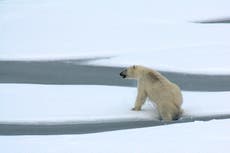Scientists ‘ping’ in the New Year with sonar project aiming to map entire ocean floor by 2030
The research vessel has spent the past year exploring the oceans around Australia, discovering 50 new species
Your support helps us to tell the story
From reproductive rights to climate change to Big Tech, The Independent is on the ground when the story is developing. Whether it's investigating the financials of Elon Musk's pro-Trump PAC or producing our latest documentary, 'The A Word', which shines a light on the American women fighting for reproductive rights, we know how important it is to parse out the facts from the messaging.
At such a critical moment in US history, we need reporters on the ground. Your donation allows us to keep sending journalists to speak to both sides of the story.
The Independent is trusted by Americans across the entire political spectrum. And unlike many other quality news outlets, we choose not to lock Americans out of our reporting and analysis with paywalls. We believe quality journalism should be available to everyone, paid for by those who can afford it.
Your support makes all the difference.Scientists are “pinging” in the New Year off the coast of Australia with a sonar wave project to launch a decade of ocean exploration.
The Falkor research vessel is gathering the first seafloor data of 2021 by sending sonar waves to “ping” off the ocean floor at midnight on December 31, the first stake in a global effort to map the bottom of the seas by 2030.
So far 19 per cent of the global seafloor has been mapped, the Seabed 2030 initiative reported.
The vessel from the Schmidt Ocean Institute, founded by former Google CEO Eric Schmidt and wife Wendy, has spent the past year exploring the oceans around Australia.
Among the team’s discoveries have been 50 new species, including a 45-meter siphonophore, believed to be earth’s longest sea creature, in the remote Ningaloo Canyon off the west coast of Australia.
A new coral reef taller than the Empire State Building was discovered while mapping the seafloor of the northern Great Barrier Reef.
In August, the team discovered five undescribed species of black coral and sponges, along with Australia’s first observation of rare scorpionfish in the Coral Sea and Great Barrier Reef Marine Parks.
In February, deep sea coral gardens and graveyards were found in Bremer Canyon Marine Park.
A study earlier this year, by the ARC Centre of Excellence for Coral Reef Studies at James Cook University, found that more than 50 per cent of corals that once made up the Great Barrier Reef have died over the last 25 years due to the impacts of the climate crisis.
January 1, 2021, marks the start of the UN Decade of Ocean Science, a global initiative to explore and protect the Earth’s oceans.
It’s hoped that having a better understanding of the world’s oceans will improve storm and tsunami predictions and allow for more detailed assessment of climate change.
A deeper insight into ocean circulation will also reveal more about where in the waters microplastics are accumulating, according to experts.
The expedition is seeking to map significant seafloor features in the Tasman and Coral seas, off the coast of Eastern Australia.
"We are still learning a lot about the complexity of the seafloor and are always discovering new features," said co-chief scientist Dr Helen Bostock from the University of Queensland.
"These features provide information about the evolution of the ocean, while features like volcanic seamounts commonly support vulnerable marine ecosystems and are nurseries for deep sea fish. It is important that we improve the map of the seafloor to help manage the oceans and their resources sustainably into the future."
The expedition will continue mapping the Tasman and Coral seas through to January 26.




Join our commenting forum
Join thought-provoking conversations, follow other Independent readers and see their replies
Comments